![]()
Aroids and other genera in the Collection
Take the Tour Now?
Orchids
The
Exotic Rainforest
Plants in
the Exotic Rainforest Collection
Epipremnum aureum
(Linden & André)
G.S. Bunting
Commonly grown as a house plant!
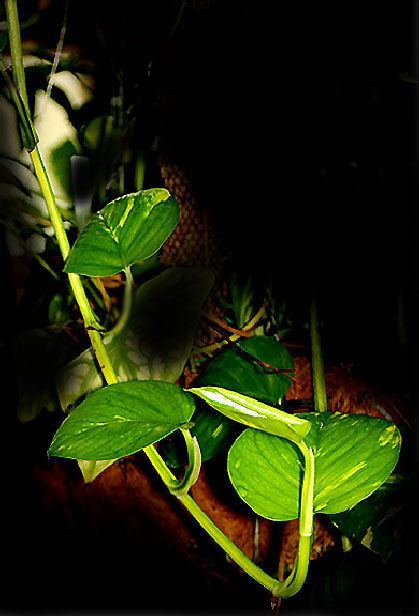
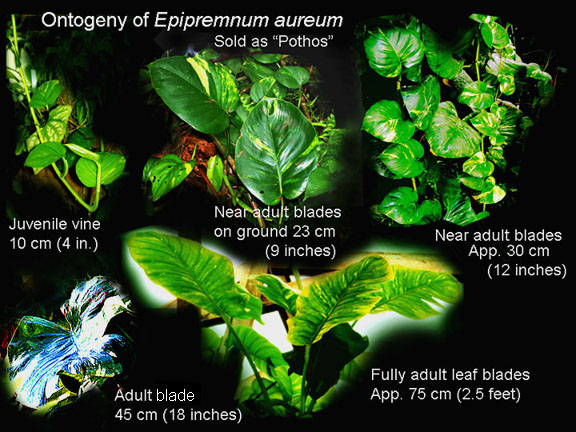
Epipremnum aureum
(Linden & André) G.S. BuntingSynonyms: Pothos aurea, Epipremnum mooreens,eRhaphidophora aurea, Scindapsus aureus
Common names:
Pothos, Giant Golden Pothos, Neon Pothos, "Ivy", Devil's Ivy, Devil's Claw Ivy,
Marble Queen, Hi Color, Golden Hunter's Robe, Goldene Efeutute
Epipremnum aureum (Linden & Andre) G. S. Bunting.
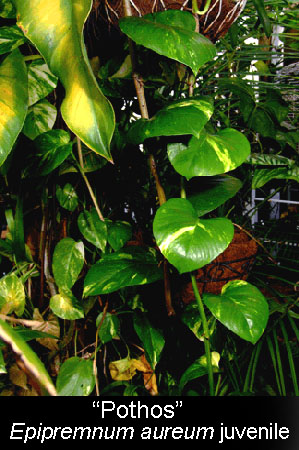
Epipremnum aureum was originally published to science as Pothos aureus Linden & André in 1880. The original name (Pothos aureus) is now considered a basionym since the plant was later found to have been originally placed in the wrong scientific genus. After study, and some scientific disagreement (discussed in this article), it was again published correctly in 1964 by botanist George Bunting in the Annals of the Missouri Botanical Garden 50: 28. A basionym is the first name applied to a new species which may not have been accepted by later workers as a result of further research, sometimes due to learning the plant has been placed in the wrong genus as in this case.
As aroid botanist Peter Boyce explains in volume 32 of the journal of the International Aroid Society, Aroideana, 2009 (page 15, volume 32), Pothos is a completely different genus containing 65 species. Plants in this genus look very little like Epipremnum aureum. Every genus has a specific set of defined characteristics and with this species several of those characteristics did not match the definition of the genus Pothos. Still, despite the fact it is not a member of the original genus it is commonly called a "Pothos" by plant collectors worldwide.
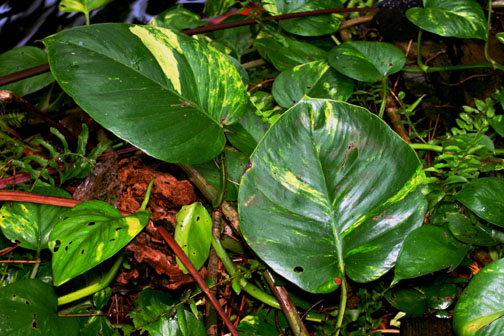 The
most common of all "house plants", Epipremnum aureum is
available at almost any garden center but until 2004 no one
could tell you for certain where it naturally originated.
Finally, aroid botanist Pete Boyce clearly established the species
was native to the island of Moorea in the Society Islands, north of Australia.
Although not a native,
Epipremnum aureum is now common on many Pacific islands as
well as Malaysia, in Hawaii, Central and South America, Southern Florida and
the Caribbean due to the release of imported plants. E.
aureum is so wide
spread in Hawaii it is considered an invasive species. As you
will see in this article, this common plant is only the juvenile form of a species capable of
growing much larger.
The
most common of all "house plants", Epipremnum aureum is
available at almost any garden center but until 2004 no one
could tell you for certain where it naturally originated.
Finally, aroid botanist Pete Boyce clearly established the species
was native to the island of Moorea in the Society Islands, north of Australia.
Although not a native,
Epipremnum aureum is now common on many Pacific islands as
well as Malaysia, in Hawaii, Central and South America, Southern Florida and
the Caribbean due to the release of imported plants. E.
aureum is so wide
spread in Hawaii it is considered an invasive species. As you
will see in this article, this common plant is only the juvenile form of a species capable of
growing much larger.
Some
websites indicate Epipremnum aureum is truly a form of
Epipremnum pinnatum, however more than one of the world's top
aroid botanists have stated Epipremnum pinnatum is completely
different species. In the pinnate
adult form (multi-lobed) the majority of specimen
of Epipremnum aureum still possess either an oval or ovate leaves
when fully
grown while Epipremnum pinnatum takes on a very different
shape. Only in the extreme adult stages do the leaves of
E. aureum become pinnatified.
A pinnate leaf is one with leaflets arranged more or less like a
feather. Examine some of the
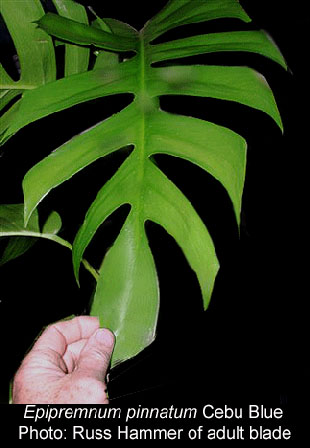 adult photos on this page and you will
see leaves of both species with divisions.
Pinnate leaves do not occur in the juvenile leaves on a kitchen or
bathroom counter.
adult photos on this page and you will
see leaves of both species with divisions.
Pinnate leaves do not occur in the juvenile leaves on a kitchen or
bathroom counter.
Some of the distinctions between the two species include a distinctive netted sheath that is present in E. pinnatum but absent in E. aureum. The “pin holes in the leaf lamina which is a common characteristic of E. pinnatum are far fewer in number and do not completely develop remaining barely if ever perforate in Epipremnum aureum. E. aureum is also more shallowly pinnate. Epipremnum aureum grows faster and is considerably more robust producing many climbing stems while E. pinnatum is noticeably slower growing.
See Epipremnum pinnatum at this link.
Epipremnum aureum has been controversial though out its history. Botanical science is always growing and learning and as a result, there is change. The "name" problems for this species are a result of earlier botanists being unsure of its proper genus placement but also as a result of the species rarely being seen in flower. The inflorescence of an aroid species is very important to the final determination of the correct species and genus due to differences in the tiny sexual parts of the spadix.
Even though E. aureum was originally published as a Pothos it was later discovered the genus placement was based on juvenile plant material that was sterile. Juvenile plants are not reliable to determine a species since they possess the ability to morph and change shape as they grow as can be seen on this page. Those changes in form are known as the natural ontogeny of any living being. Just look at the childhood photos of any human being and you are looking at ontogeny, living beings change as they grow.
The genus placement was challenged in 1908 since in part it did not possess the characteristics or appear anything like a plant in the genus Pothos. Botanist Adolf Engler removed the species from the original genus in 1908 and transferred it, (again incorrectly), to the genus Scindapsus.
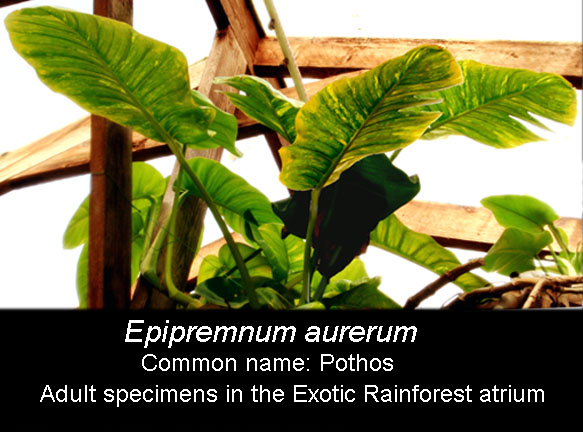 The
plant remained in that genus until botanist Monroe
Birdsey reported the first recorded flowerings in 1962 of the species in
both
Puerto Rico and at the Fairchild Tropical Garden in Miami, Florida.
At that time Monroe was able to examine the sexual parts of the
inflorescence. He then published the species as
Rhaphidophora aurea in 1963 but later apparently indicated the plant should be in the genus
Epipremnum
The
plant remained in that genus until botanist Monroe
Birdsey reported the first recorded flowerings in 1962 of the species in
both
Puerto Rico and at the Fairchild Tropical Garden in Miami, Florida.
At that time Monroe was able to examine the sexual parts of the
inflorescence. He then published the species as
Rhaphidophora aurea in 1963 but later apparently indicated the plant should be in the genus
Epipremnum
Unaware of Birdsey's finding another botanist (Nicholson) apparently felt there were insufficient differences for the two species Epipremnum aureum and Epipremnum pinnatum to be distinct and proposed Epipremnum aureum be regarded as cultivar of E. pinnatum. Finally, botanist George Bunting eventually transferred Pothos aureus to the genus Epipremnum writing that ''flowering material is very similar to that qf Epipremnum pinnatum" but eventually publishing the plant as Epipremnum aureum in 1964.
In
a personal email from my mentor aroid botanist Dr. Thomas B. Croat
Ph.D., P.A. Schulze Curator of Botany of the Missouri Botanical
Garden regarding that subject Tom indicates currently accepted
science has determined the two
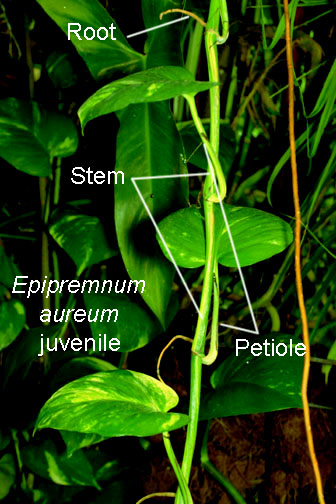 species are distinct, Dr. Croat is considered to be the
top aroid botanist in North America and wrote,
"There was a time
when it was believed that Epipremnum pinnatum and E. aureum were the
same species but Peter Boyce now says that
E. aureum is different
and is endemic to some part of the Pacific."
species are distinct, Dr. Croat is considered to be the
top aroid botanist in North America and wrote,
"There was a time
when it was believed that Epipremnum pinnatum and E. aureum were the
same species but Peter Boyce now says that
E. aureum is different
and is endemic to some part of the Pacific."
According to scientific sources such as the Royal Botanic Garden Kew in London and TROPICOS (a scientific service of the Missouri Botanical Garden) both Epipremnum aureum and Epipremnum pinnatum now considered valid species. Still, some internet sources insist the specimen shown on this page is nothing more than a natural form of Epipremnum pinnatum and not a species at all.
As an example, the stalk that supports any leaf is not a "stem". The stalk that supports a leaf blade is called a petiole. A stem is the plant's base or central axis and main support. A stem is easily distinguished from a petiole since it is normally divided into nodes and internodes. The nodes often produce a leaf but you must remember a leaf is composed of two parts, the petiole and the blade and that scientific information often leads to a great deal of confusion on internet forums.
If you do not have a good understanding of the natural variation in plant species as well as why every leaf on a plant does not have to appear the same, please read the link on Natural variationI
Aroids including
Epipremnum aureum are highly variable and produce many color forms.
In addition to the common form
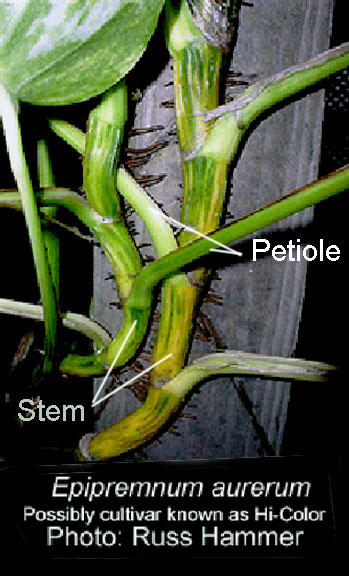 of Epipremnum aureum with
yellow variegation you can also find plants with no variegation at
all that produces totally green leaves as well as a hybrid form
known as Marble Queen that will produce white variegation. There is
a form known as 'Hi-Color' that produces a yellow coloration on
the stem (often incorrectly called the cane).
of Epipremnum aureum with
yellow variegation you can also find plants with no variegation at
all that produces totally green leaves as well as a hybrid form
known as Marble Queen that will produce white variegation. There is
a form known as 'Hi-Color' that produces a yellow coloration on
the stem (often incorrectly called the cane).
Epipremnum aureum is almost never seen in the pinnate form in a pot. In late March of 2008 our specimen finally began to develop those pinnatified leaves after years of climbing the center post of our tropical atrium. The photo at the top of this page was taken by my friend Linn Rice from a tall ladder leaning directly above the pond at approximately the 5 meter (16 foot) level of the Exotic Rainforest atrium. The large leaves to the lower right corner of that photo are Philodendron sagittifolium and each blade is quite large.
In discussing the forms of this species with expert grower Russ Hammer from Central Florida Russ made these observations, "Some decades ago, the yellow-variegated form was not as colorful, variegation was confined to the leaves only. Then nurseries began selling a form with yellow-striped or entirely yellow stems. I remember one commercial name given to it was Hi-Color among others. I see both clones being sold today, but in comparing one form to the other, to my eye the variegated stems make a noticeable difference in attractiveness. Then again, this is something I look for in aureum when I see them, but maybe it's not something others even notice."
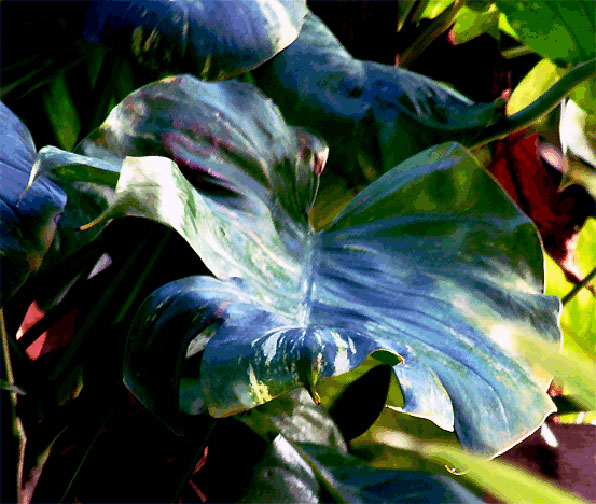 Epipremnum aureum
is an aroid. An aroid is a plant that reproduces by producing an
inflorescence known to science as
a spathe and spadix supported by a
stalk known as a peduncle. Allthough collectors comonly
believe it is, the spathe itself is not a flower. Instead,
the flowers are tiny
and are located on the spadix.
Epipremnum aureum
is an aroid. An aroid is a plant that reproduces by producing an
inflorescence known to science as
a spathe and spadix supported by a
stalk known as a peduncle. Allthough collectors comonly
believe it is, the spathe itself is not a flower. Instead,
the flowers are tiny
and are located on the spadix.
Rarely seen on Epipremnum aureum, t
he spathe is a specially modified leaf appearing to be a hood whose purpose is to protect the spadix at its center. The spadix is a spike on a thickened fleshy axis which produces tiny flowers once the plant becomes sexually active. On the spadix of a fertile inflorescence there can be found very tiny true flowers when the plant is at anthesis (sexual reproduction). When ready to reproduce the male flower portions then produce pollen and if the female flowers are pollinated by an appropriate insect they will produce berries containing seeds. Part of nature's plan is to have those berries eaten by rain forest animals and thus perpetuate the species throughout the rain forest.Despite commonly held misconceptions and although similar, Epipremnum aureum is neither a Philodendron nor a Monstera. Philodendron and Monstera species are not naturally found outside the NeoTropics (Mexico, Central America, South America and the Caribbean). Even though Philodendron and Monstera can now be found growing wild throughout the world, those not found in the NeoTropical zone are not native. All Philodendron plants growing around the world other than those in Central America, South America and the Caribbean were imported.
Chances are you’ve grown Epipremnum aureum but I’d venture your plant hasn't grown as large as it is capable! Within one year of planting our specimen of Epipremnum aureum the plant had reached the top of our center post which is just less than 4 meters (12 feet) tall. The leaves began to grow much larger as the plant approached the 4 meter (12 foot) mark and once it reached the top of the building at 5.3 meters (16 plus feet) the leaves had reached from 36cm (14.5 inches) to over 45cm (18 inches) in size. The higher they climb, the larger and longer they grow.
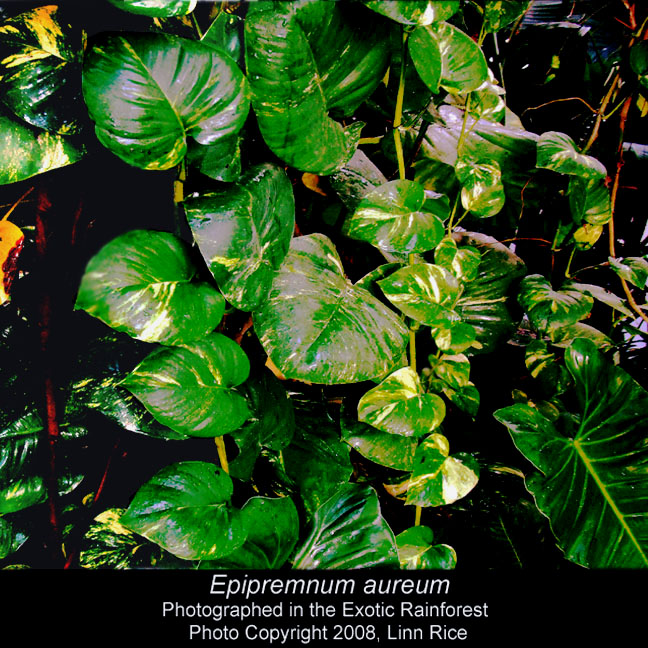 The leaves
in the photo (right) are nearly 30 cm (12 inches) and are
substantially larger than those we originally planted. Blades like
these also hang near the top of a vine that has grown back down from the
rafters but again become smaller as they reach the ground.
The leaves
in the photo (right) are nearly 30 cm (12 inches) and are
substantially larger than those we originally planted. Blades like
these also hang near the top of a vine that has grown back down from the
rafters but again become smaller as they reach the ground.
The petioles that support each of the largest leaves grow to approximately 60 cm (24 inches) in length. Only the ovate plants in the photo at the right are Epipremnum aureum, the elongated leaf in the lower right corner is a different species known as Philodendron sagittifolium. The blade in the corner is over 60 cm (2 feet) long.
Once the specimen reached the cross beam which runs from the east wall to the west wall it then began to grow in either direction and to drop long vines which now hang into the pond and to the ground on all sides of the center post. Some grew back down to the level of the pond, skim across the surface, then turn to grow back to the soil on either bank of the pond. From there, the plants begin climbing up the waterfall and back up the center post once again.
The stem of our Epipremnum aureum just half way up the post is over 2.55 cm (2 inches) thick and growing thicker as they climb.
Since Epiprimnum aureum is tropical it prefers bright light, high humidity and fast draining soil. For recommendations on growing this species read this link on growing Philodendron species.
Want to know more
about aroids?
Join the
International Aroid Society:
http://www.exoticrainforest.com/Join%20IAS.html